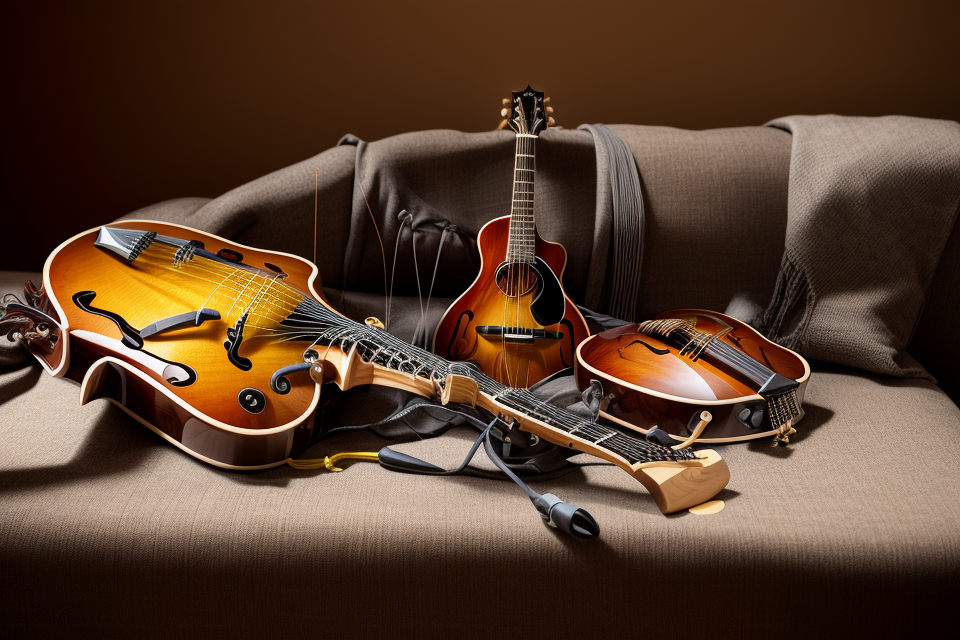Welcome to the fascinating world of mandolin performers! The mandolin is a stringed instrument that has been around for centuries, originating from Europe and eventually becoming a staple in American bluegrass and folk music. But what do you call a person who plays the mandolin? Is it a mandolinist, a mandoliner, or something else entirely? In this article, we’ll explore the various terms used to describe mandolin players and dive into the rich history and culture of this unique instrument. So grab your mandolin and join us on this musical journey!
The Basics of Mandolin Playing
What is a mandolin?
- Brief history and origin of the mandolin
The mandolin is a stringed musical instrument of the lute family, which has been used in various forms for centuries. Its origins can be traced back to Central Asia, where it was played by nomadic tribes. From there, it spread to Europe, where it evolved into the instrument we know today.
* Types of mandolins and their differences
There are several types of mandolins, each with its own unique characteristics and uses. The most common types include:
+ Acoustic mandolin: This is the most traditional type of mandolin, which has a wooden body and is typically played with a pick or fingers.
+ Electric mandolin: This type of mandolin has a pickup and is amplified through an instrument amplifier or a PA system. It is often used in genres such as bluegrass, rock, and jazz.
+ Mandola: This is a larger version of the mandolin, with a deeper body and longer neck. It has a lower pitch and is often used in ensembles or as a solo instrument.
+ Octave mandolin: This type of mandolin is tuned an octave lower than a standard mandolin and has a deeper body and longer neck. It is often used in Celtic and folk music.
How to play the mandolin
- Holding the Mandolin: The first step in playing the mandolin is to hold it properly. The mandolin has a body, neck, and a headstock. The body is typically made of wood and has a round or oval shape. The neck is long and slender, and it connects the body to the headstock. The headstock has tuning pegs that are used to adjust the strings’ tension. The mandolin is held on the lap or between the legs, with the body resting on the left thigh and the neck extending to the left hand.
- Picking Techniques: The mandolin is typically played with a pick, but it can also be played with the fingers. The pick is held between the thumb and index finger, and it is used to strum or pluck the strings. Fingerpicking involves using the fingers to pluck or strum the strings individually or in combinations.
- Chords and Scales: Mandolin chords are played by pressing down on the strings with the fingers or the pick. The most common chords are the major, minor, seventh, and fifth chords. Mandolin scales are played by playing individual strings or strings in combinations. The most common scales are the major and minor scales.
- Famous Mandolin Players and Their Styles: The mandolin has been played by many famous musicians, including Bill Monroe, Alison Krauss, and Chris Thile. Each of these musicians has developed their own unique style of playing the mandolin, incorporating elements of bluegrass, country, and classical music.
The Mandolin in Different Genres
Bluegrass music and the mandolin
The mandolin is an essential instrument in the genre of bluegrass music, which originated in the southern United States in the 1940s. Bluegrass music is characterized by its fast tempo, complex harmonies, and emphasis on traditional Appalachian musical styles. The mandolin’s distinctive sound and versatility make it an ideal instrument for bluegrass music, where it often takes the lead alongside the guitar, banjo, and fiddle.
Evolution of bluegrass music
Bluegrass music evolved from traditional mountain music, incorporating elements of Scottish, Irish, and English folk music, as well as African-American musical traditions. The term “bluegrass” was first used by the musician Bill Monroe, who is considered the father of bluegrass music. Monroe’s band, the Blue Grass Boys, played a key role in popularizing the genre in the 1940s and 1950s.
Over the years, bluegrass music has continued to evolve, incorporating new influences and experimenting with different sounds. Today, bluegrass music is a thriving genre with a dedicated fan base and a lively scene of musicians, festivals, and workshops.
Key mandolin players in bluegrass
Throughout the history of bluegrass music, there have been many talented mandolin players who have contributed to the development of the genre. Some of the most influential mandolin players in bluegrass include:
- Bill Monroe: As mentioned earlier, Monroe is considered the father of bluegrass music and was a master mandolin player. His distinctive style, characterized by fast and complex picking, set the standard for bluegrass mandolin playing.
- Earl Scruggs: Scruggs was a pioneering banjo player, but he also played mandolin in several iconic bluegrass bands, including Flatt and Scruggs. His mandolin playing was known for its clarity and precision, and he introduced a new style of mandolin playing called “Scruggs-style” picking.
- David Grisman: Grisman is a mandolin player and composer who has made significant contributions to the development of bluegrass and acoustic music. He has collaborated with many other musicians and has been influential in the development of the “Dawg” style of music, which blends bluegrass with jazz and classical music.
- Sam Bush: Bush is a virtuosic mandolin player who has been active in the bluegrass scene since the 1970s. He has played with several prominent bluegrass bands and has also collaborated with other musicians across different genres. Bush’s playing is known for its energy, creativity, and technical skill.
These mandolin players, along with many others, have helped to shape the sound and style of bluegrass music, making the mandolin an essential instrument in this vibrant and dynamic genre.
Classical music and the mandolin
The mandolin has a rich history in classical music, dating back to the 18th century. It was initially used in operas and orchestral performances, but eventually became a standalone instrument in its own right. One of the most famous composers for the mandolin was Ludwig van Beethoven, who wrote a number of pieces for the instrument.
- History of the mandolin in classical music: The mandolin has been used in classical music for over 200 years. It was first introduced to Europe in the late 1700s and quickly became popular in orchestral and operatic performances. Italian composers, such as Nicolo Paganini, wrote a number of pieces for the mandolin, which helped to establish it as a solo instrument.
- Famous classical mandolin pieces: There are a number of famous classical mandolin pieces that are still performed today. Beethoven’s “Mandolin Concerto in D Major” is one of the most well-known pieces, and is still regularly performed by mandolinists around the world. Other famous composers who wrote for the mandolin include Franz Schubert, Felix Mendelssohn, and Pyotr Ilyich Tchaikovsky.
Despite its origins in classical music, the mandolin is also commonly used in other genres, such as bluegrass and folk music. The versatility of the instrument allows it to be used in a wide range of musical styles, making it a popular choice for musicians around the world.
Pop and rock music and the mandolin
The mandolin has found its way into various genres of music, but none more so than in pop and rock music. Its unique sound and versatility have made it a popular choice for musicians looking to add a new dimension to their music. In this section, we will explore the role of the mandolin in modern pop and rock music, as well as some famous songs that feature the instrument.
The mandolin in modern pop and rock music
In recent years, the mandolin has become a staple in modern pop and rock music. Many artists have incorporated the instrument into their music, bringing a fresh and unique sound to their songs. The mandolin’s ability to create a distinctive and catchy melody has made it a sought-after instrument in the music industry.
Some popular artists who have used the mandolin in their music include Mumford & Sons, The Lumineers, and Ed Sheeran. These artists have helped to popularize the mandolin in pop and rock music, showcasing its versatility and unique sound.
Famous pop and rock songs featuring the mandolin
The mandolin has been featured in many famous pop and rock songs over the years. One of the most well-known songs is “Little Talks” by Of Monsters and Men. The mandolin’s haunting melody sets the tone for the song, creating an eerie and captivating atmosphere.
Another famous song that features the mandolin is “I Will Follow You into the Dark” by Death Cab for Cutie. The mandolin adds a sense of urgency and intensity to the song, creating a powerful and emotional atmosphere.
Other notable songs that feature the mandolin include “Ho Hey” by The Lumineers, “Little Lion Man” by Mumford & Sons, and “The A Team” by Ed Sheeran. These songs demonstrate the versatility of the mandolin and its ability to add depth and emotion to a song.
In conclusion, the mandolin has played a significant role in pop and rock music over the years. Its unique sound and versatility have made it a popular choice for musicians looking to add a new dimension to their music. As the instrument continues to evolve, it will be interesting to see how it is incorporated into future pop and rock songs.
Famous Mandolin Players
Bill Monroe
Early life and influences
Bill Monroe was born on September 13, 1911, in Rosine, Kentucky. He was the youngest of eight children and grew up in a musical family. His parents were both musicians, and his father played the fiddle while his mother played the guitar. Monroe’s early exposure to music influenced his later decision to become a musician.
In addition to his family’s musical background, Monroe was also influenced by the music of the Appalachian region. He grew up listening to traditional mountain music, which later became a significant influence on his mandolin playing style.
Mandolin playing style and technique
Monroe’s mandolin playing style was characterized by his fast and complex fingerpicking technique. He used a unique style of playing called “frailing,” which involved striking the strings with the fingers in a downward motion. This technique allowed him to play multiple notes simultaneously and create a distinctive sound that became his trademark.
Monroe’s playing style was also influenced by his early exposure to jazz music. He incorporated elements of jazz into his mandolin playing, including chord progressions and improvisation. This made him one of the first mandolin players to explore jazz influences in traditional mountain music.
Legacy in bluegrass music
Monroe is widely regarded as the “Father of Bluegrass Music.” He created a new genre of music that blended traditional mountain music with elements of jazz, country, and blues. His mandolin playing was a key component of this new sound, and his influence on bluegrass music is immeasurable.
Monroe’s impact on bluegrass music extended beyond his own performances. He also helped to promote and popularize the genre by forming the first bluegrass band, the Blue Grass Boys. The band included other notable musicians such as Charlie McCoy and Lester Flatt, and they toured extensively throughout the United States.
In addition to his musical contributions, Monroe was also a skilled songwriter. He wrote many classic bluegrass songs, including “Blue Moon of Kentucky” and “Uncle Pen.” These songs have become standards in the genre and continue to be performed by bluegrass musicians today.
Overall, Bill Monroe’s mandolin playing style and influence on bluegrass music have made him one of the most important figures in the history of mandolin performance. His legacy continues to inspire new generations of musicians and music lovers around the world.
Johnny Cash
Johnny Cash was an American singer-songwriter, actor, and author who was known for his distinctive voice and his ability to write songs that spoke to the hearts of his listeners. He was born on February 26, 1932, in Kingsland, Arkansas, and was raised in a poor family. His early life was marked by poverty, and he was exposed to country and gospel music from a young age.
Cash’s mandolin playing style was heavily influenced by his early exposure to country and gospel music. He often used a picking style that emphasized the bass notes, which gave his playing a strong rhythmic drive. Cash was also known for his ability to play chords on the mandolin, which added depth and complexity to his playing.
In addition to his mandolin playing, Cash was also a skilled songwriter. He wrote many of his own songs, including some of his most famous hits, such as “Folsom Prison Blues” and “Ring of Fire.” Cash’s songs often dealt with themes of love, loss, and redemption, and his music had a universal appeal that transcended genre boundaries.
Cash’s legacy in country and rock music is significant. He was inducted into the Country Music Hall of Fame in 1988 and the Rock and Roll Hall of Fame in 1992. His music has been covered by countless artists, and his influence can be heard in many genres of music. Even today, Cash remains one of the most beloved and respected figures in American music.
Andy Statman
Andy Statman was born on November 2, 1947, in Washington Heights, New York. He was raised in a Jewish family and began playing the mandolin at the age of 10. Statman’s early influences were jazz and classical music, and he was particularly drawn to the playing of violinist Jascha Heifetz.
Statman is known for his unique and innovative playing style, which combines elements of bluegrass, jazz, and classical music. He is a master of the mandolin’s various techniques, including chord melody, crosspicking, and double stops. Statman’s playing is characterized by his fast and intricate fingerwork, as well as his use of extended techniques such as harmonics and tremolo.
Legacy in Jewish and bluegrass music
Andy Statman is widely regarded as one of the most important figures in the world of Jewish and bluegrass music. He has recorded numerous albums of both Jewish and bluegrass music, and has collaborated with a wide range of musicians, including Dave Grisman, John Sebastian, and Don Grusin. Statman’s contributions to both genres have been recognized with several awards, including a National Heritage Fellowship from the National Endowment for the Arts.
Today, Statman continues to perform and record, and remains an influential figure in the world of mandolin playing. His innovative approach to the instrument has inspired countless musicians, and his contributions to both Jewish and bluegrass music have helped to broaden the horizons of both genres.
Mandolin Performances and Recordings
Iconic mandolin performances
Bill Monroe’s “Blue Moon of Kentucky”
- Born on April 13, 1911, in Butler County, Ohio, Bill Monroe is widely regarded as the “Father of Bluegrass Music.”
- He began his music career in the late 1920s as a part of the Monroe Brothers duo, along with his younger brother Charlie.
- In 1936, Monroe founded the Blue Grass Champions, which later became the Blue Grass Boys, and they went on to record several iconic mandolin pieces, including “Blue Moon of Kentucky.”
- The song, originally recorded by Tennesse Ernie Ford in 1947, was covered by Monroe and his band in 1949. Their version became an instant hit and is now considered a staple of bluegrass music.
Johnny Cash’s “Folsom Prison Blues”
- Johnny Cash, one of the most influential American musicians of the 20th century, recorded “Folsom Prison Blues” in 1955.
- The song tells the story of a man imprisoned for life, pining for freedom and his lover.
- Cash’s unique voice and powerful lyrics, accompanied by his distinctive rhythmic strumming on the mandolin, have made this song an enduring classic of country and rock music.
- “Folsom Prison Blues” has been covered by numerous artists, but Cash’s original remains the most iconic and influential version.
Andy Statman’s “Kol Nidre”
- Andy Statman is a mandolin player and composer known for his innovative style that blends traditional Jewish music with bluegrass and other genres.
- “Kol Nidre,” which is traditionally sung at the beginning of the Jewish High Holidays, has been adapted and arranged by Statman for the mandolin.
- His version of the song showcases his technical prowess on the instrument while also paying homage to his Jewish heritage.
- Statman’s interpretation of “Kol Nidre” has become a beloved and influential performance in the world of mandolin music.
Mandolin recordings to know
Bill Monroe’s “Blue Grass”
- Bill Monroe, widely regarded as the “Father of Bluegrass,” recorded “Blue Grass” in 1940.
- The song showcases Monroe’s unique style, combining elements of blues, jazz, and country music with the mandolin.
- “Blue Grass” became an instant hit and established Monroe as a pioneer in the genre.
Johnny Cash’s “At Folsom Prison”
- Johnny Cash’s 1968 live album “At Folsom Prison” features the mandolin prominently throughout the performance.
- Cash’s distinctive voice and powerful message resonated with both prisoners and audiences alike, making the album a commercial success.
- The mandolin adds a haunting quality to the tracks, enhancing the emotional impact of the lyrics.
Andy Statman’s “The Musichirem”
- Andy Statman, a prominent Jewish-American mandolin player, released “The Musichirem” in 1997.
- The album combines traditional Jewish melodies with bluegrass and folk elements, creating a unique sound that celebrates both heritage and innovation.
- Statman’s virtuosity on the mandolin is evident throughout the album, showcasing the instrument’s versatility and range.
The Future of Mandolin Playing
New mandolin players and innovations
As the mandolin continues to evolve, so does the world of mandolin players. In this section, we will explore the new generation of mandolin players and the innovations they bring to the instrument.
Up-and-coming mandolin players
One of the most exciting developments in the world of mandolin playing is the emergence of a new generation of talented musicians. These young players are pushing the boundaries of what is possible on the mandolin, incorporating elements of bluegrass, jazz, and other genres into their music.
For example, 22-year-old American mandolinist Joe K. Walsh has been making waves in the bluegrass scene with his virtuosic playing and innovative compositions. Another rising star is 25-year-old Canadian mandolinist Tristan Carter, who has been praised for his unique blend of classical and contemporary styles.
As these young players continue to develop their skills and push the boundaries of the instrument, the future of mandolin playing looks bright.
Mandolin innovations in modern music
In addition to the emergence of new mandolin players, there are also exciting developments in the realm of mandolin innovations. Many modern musicians are experimenting with new techniques and sounds, pushing the instrument into new territories.
For example, some mandolin players are incorporating electronic effects and loops into their music, creating a unique sound that blends traditional mandolin playing with modern technology. Others are exploring new tunings and techniques, such as the use of the bass mandolin, which allows for a wider range of sounds and styles.
Overall, the future of mandolin playing looks promising, with new players and innovations continually pushing the boundaries of the instrument. As the mandolin continues to evolve, it will be exciting to see where these developments lead.
The mandolin in the digital age
With the advancement of technology, the mandolin has found its way into the digital age. Here are some ways the mandolin is thriving in the digital world:
- Online resources for mandolin players
- Mandolin tablature and sheet music available online
- Video lessons and tutorials on various platforms
- Online forums and communities for mandolin players to connect and share knowledge
- Virtual mandolin performances and collaborations
- Live-streamed concerts and performances
- Collaborations with other musicians around the world through video conferencing
- Recording and sharing of original music and covers on social media platforms
These digital resources have opened up new opportunities for mandolin players to learn, perform, and connect with other musicians. The internet has made it easier than ever for mandolin players to access information and resources, and to share their passion for the instrument with others.
The mandolin in global music
- The mandolin has been embraced by musicians and audiences worldwide, resulting in its widespread popularity across various genres and cultures.
- Its versatility and adaptability have enabled it to thrive in diverse musical contexts, reflecting the rich history and evolution of the instrument.
- Mandolin playing has been influenced by various traditions, resulting in the creation of unique styles and sounds that blend elements from different cultures.
- Collaborations between mandolin players and musicians from different backgrounds have become increasingly common, fostering creativity and innovation in the instrument’s usage.
- As globalization continues to shape the music industry, the mandolin’s presence in various genres is likely to grow, with more artists incorporating it into their music and experimenting with its potential.
FAQs
1. What is a mandolin?
A mandolin is a stringed musical instrument that is commonly used in various genres of music, including bluegrass, folk, and classical music. It has four pairs of strings, which are plucked or strummed with a pick or fingers to produce sound.
2. What does a person who plays the mandolin called?
A person who plays the mandolin is commonly referred to as a mandolinist. This term is used to describe both amateur and professional musicians who play the mandolin.
3. Are there different types of mandolins?
Yes, there are several types of mandolins, including the Italian mandolin, the Neapolitan mandolin, the Irish mandolin, and the Gibson-style mandolin, among others. Each type of mandolin has its own unique features and is used in different genres of music.
4. What kind of music is typically played on a mandolin?
Mandolins are commonly used to play a variety of music genres, including bluegrass, folk, classical, and Celtic music. They are also used in some pop and rock music recordings.
5. How do I become a mandolinist?
To become a mandolinist, you will need to start by learning the basics of the instrument, such as how to hold it, tune it, and play simple melodies. You can take lessons from a professional mandolin teacher or learn through online resources and tutorials. Practice is key to becoming proficient on the mandolin, so be sure to set aside time each day to work on your skills.



